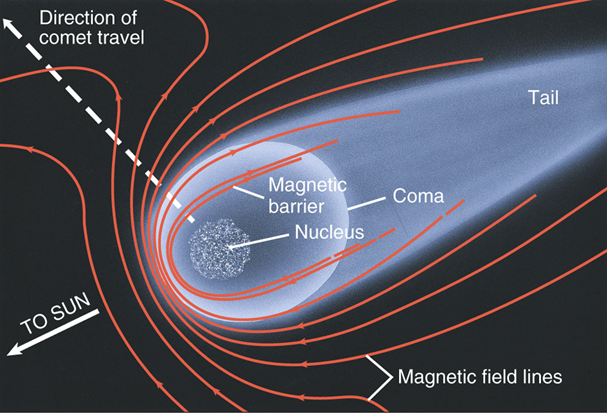Asteroids, Comets, & Meteors
So, what's the difference between an asteroid, a comet, and a meteor? The American Meteor Society has the answer for you on this handy poster!
Asteroids
Most asteroids lie between Mars and Jupiter in an area called the Asteroid Belt. They are small bodies - the largest (Ceres) is about 620 miles in diameter - with irregular shapes, and some have very eccentric orbits. Many of the recent impacts on the Moon and Earth were collisions with asteroids.
The origin of asteroids is uncertain.
NASA's Galileo spacecraft was the first to observe an asteroid close-up
- Gaspra (1991)

- Ida (1993)
The Near Earth Asteroid Rendezvous (NEAR) Program has racked up a few firsts as well, including the first man-made object to:
- orbit an asteroid (Eros on 2/14/00)
- Touchdown on an asteroid (Eros on 2/12/01)

Comets
Comets are often compared to large, "dirty snowballs" due to their composition of frozen gases mixed with rocky and metallic materials. These frozen gases vaporize when near the Sun. This produces a glowing head called the coma. Some may develop a tail that points away from the Sun due to radiation pressure and the solar wind. The origin of comets is not well known although they are thought to form at great distance from the Sun. Most come from a region of icy bodies beyond the orbit of Neptune - The Kuiper (pronounced Ki-Per) Belt.
NASA/JPL's Deep Impact Project was designed to discover the origins of the universe and the composition and structure of comets by making a crater in Comet Tempel 1. Their objectives were :
- Observe how the crater forms
- Measure the crater's depth and diameter
- Measure the composition of the interior of the crater and its ejecta
- Determine the changes in natural outgassing produced by the impact
 |
From: Tempel 1 Composite Map Arrows a and b point to large, smooth regions. The impact site is indicated by the third large arrow. Small grouped arrows highlight a scarp (a cliff or steep slope along the edge of a plateau) that is bright due to illumination angle. They show a smooth area to be elevated above the extremely rough terrain. The white scale bar in the lower right represents 1 km across the surface of the comet nucleus. The two directional arrows (vectors) in the upper right point to the Sun and Celestial North. CREDIT: NASA/UMD/M. F. A'Hearn et al., Science 310, 258 (2005); published online 8 September 2005 (10.1126/science.1118923). |
 |
Temperature Map and Three Ice Rich Regions on Tempel 1's Surface |
The European Space Agency (ESA) made history on 11/12/14 when the Philae lander landed on comet 67P/Churyumov–Gerasimenko.
Goals:
- ☑ Catch comet 67P/Churyumov-Gerasimenko in 2014 and accompany it into the interior solar system.
☑ Observe the comet's nucleus and coma from close range.
☑ Deploy Philae to make first controlled landing on a comet.
☐ Measure the increase in cometary activity during perihelion (position closest to the Sun).
☐ Observe the changes associated with the change in season as the comet leaves the inner solar system on its outbound leg. At that time a different pole will be exposed to the sun


From: xkcd 1446 - Landing

Unfortunately, Philae's harpoons didn't deploy as planned and the lander bounced two or three times before coming to a stop. Where it landed wasn't idea - there was only enough sunlight available for only a few tests to be run before the batteries ran out. One of the tests conducted was to determine the composition of the ice on the comet. What they found was that the ice was composed of water - but of a different isotopic composition of that on Earth.

Another test revealed the first measurement of molecular nitrogen in a comet. This provided a clue as to how and where the comet formed. molecular nitrogen needs very low temperatures (-250°C to -220°C) to be incorporated in ice - conditions found in the outer regions of our solar system.
Finally, another test showed that the comet's nucleus is not magnetized. Scientists believe that magnetic fields within the early solar system helped to move material around during the accretion process. Meteorites contain small amounts of magnetite and magnetized iron, indicating that they were present during the early formation of the solar system. But how early? Comets are thought to be made up of some of the original particles that eventually formed our solar system. But it has been difficult to determine if comets have a magnetic field or not. Rosetta and Philae have both determined that Comet 67P/Churyumov-Gerasimenko, at least, does not.
The most famous short-period comet is Halley's comet. It has a 76 year orbital period and has a potato-shaped nucleus (16 km by 8 km). The last perihelion was 9 February 1986, and the next perihelion is 28 July 2061.

Meteoroids
Meteoroids are bits of debris that enter our atmosphere and incinerate. They are called meteors when they enter Earth's atmosphere. A meteor shower occurs when Earth encounters a swarm of meteoroids associated with a comet's path. Meteoroids are referred to as meteorites when they are found on Earth.Types of meteorites classified by their composition
- Irons - Mostly iron, 5-20% nickel
- Stony - Silicate minerals with Inclusions of other minerals
- Stony-irons – mixtures
- Carbonaceous chondrites - Rare, composed of simple amino acids and other organic material
<< back |
||
